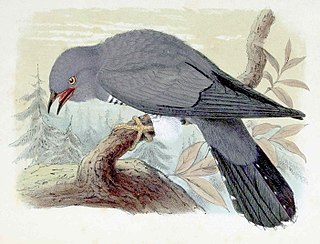Related Research Articles

Onomatopoeia is a type of word, or the process of creating a word, that phonetically imitates, resembles, or suggests the sound that it describes. Common onomatopoeias include animal noises such as oink, meow, roar, and chirp. Onomatopoeia can differ by language: it conforms to some extent to the broader linguistic system. Hence, the sound of a clock may be expressed variously across languages: thus as tick tock in English, tic tac in Spanish and Italian, dī dā in Mandarin, kachi kachi in Japanese, or tik-tik in Hindi and Bengali.

Bird vocalization includes both bird calls and bird songs. In non-technical use, bird songs are the bird sounds that are melodious to the human ear. In ornithology and birding, songs are distinguished by function from calls.

The brown-headed cowbird is a small, obligate brood parasitic icterid native to temperate and subtropical North America. It is a permanent resident in the southern parts of its range; northern birds migrate to the southern United States and Mexico in winter, returning to their summer habitat around March or April.

The northern mockingbird is a mockingbird commonly found in North America. This bird is mainly a permanent resident, but northern birds may move south during harsh weather. This species has rarely been observed in Europe. This species was first described by Carl Linnaeus in his 1758 10th edition of Systema Naturae as Turdus polyglottos. The northern mockingbird is known for its mimicking ability, as reflected by the meaning of its scientific name, "many-tongued mimic". The northern mockingbird has gray to brown upper feathers and a paler belly. Its tail and wings have white patches which are visible in flight.

The picture superiority effect refers to the phenomenon in which pictures and images are more likely to be remembered than are words. This effect has been demonstrated in numerous experiments using different methods. It is based on the notion that "human memory is extremely sensitive to the symbolic modality of presentation of event information". Explanations for the picture superiority effect are not concrete and are still being debated, however an evolutionary explanation is that sight has a long history stretching back millions of years and was crucial to survival in the past, whereas reading is a relatively recent invention, and requires specific cognitive processes, such as decoding symbols and linking them to meaning.
In cognitive psychology, chunking is a process by which small individual pieces of a set of information are bound together to create a meaningful whole later on in memory. The chunks, by which the information is grouped, are meant to improve short-term retention of the material, thus bypassing the limited capacity of working memory and allowing the working memory to be more efficient. A chunk is a collection of basic units that are strongly associated with one another, and have been grouped together and stored in a person's memory. These chunks can be retrieved easily due to their coherent grouping. It is believed that individuals create higher-order cognitive representations of the items within the chunk. The items are more easily remembered as a group than as the individual items themselves. These chunks can be highly subjective because they rely on an individual's perceptions and past experiences, which are linked to the information set. The size of the chunks generally ranges from two to six items but often differs based on language and culture.

In biology, a lerp is a structure of crystallized honeydew produced by larvae of psyllid bugs as a protective cover. These animals are commonly referred to as lerp insects, of which there are over 300 species in Australia.

The blue-black grassquit is a small Neotropical bird in the tanager family, Thraupidae. It is the only member of the genus Volatinia. It is a common and widespread bird that breeds from southern Mexico through Central America, and South America as far as northern Chile, Argentina, and Paraguay, and in Trinidad and Tobago. A male was also observed in Graham County, Arizona on July 15 and July 17, 2023.
Evolutionary musicology is a subfield of biomusicology that grounds the cognitive mechanisms of music appreciation and music creation in evolutionary theory. It covers vocal communication in other animals, theories of the evolution of human music, and holocultural universals in musical ability and processing.
Animal culture can be defined as the ability of non-human animals to learn and transmit behaviors through processes of social or cultural learning. Culture is increasingly seen as a process, involving the social transmittance of behavior among peers and between generations. It can involve the transmission of novel behaviors or regional variations that are independent of genetic or ecological factors.
Vocal learning is the ability to modify acoustic and syntactic sounds, acquire new sounds via imitation, and produce vocalizations. "Vocalizations" in this case refers only to sounds generated by the vocal organ as opposed to by the lips, teeth, and tongue, which require substantially less motor control. A rare trait, vocal learning is a critical substrate for spoken language and has only been detected in eight animal groups despite the wide array of vocalizing species; these include humans, bats, cetaceans, pinnipeds, elephants, and three distantly related bird groups including songbirds, parrots, and hummingbirds. Vocal learning is distinct from auditory learning, or the ability to form memories of sounds heard, a relatively common trait which is present in all vertebrates tested. For example, dogs can be trained to understand the word "sit" even though the human word is not in its innate auditory repertoire. However, the dog cannot imitate and produce the word "sit" itself as vocal learners can.
Metamemory or Socratic awareness, a type of metacognition, is both the introspective knowledge of one's own memory capabilities and the processes involved in memory self-monitoring. This self-awareness of memory has important implications for how people learn and use memories. When studying, for example, students make judgments of whether they have successfully learned the assigned material and use these decisions, known as "judgments of learning", to allocate study time.

A meow or miaow is a cat vocalization. Meows may have diverse tones in terms of their sound, and what is heard can vary from being chattered to calls, murmurs, and whispers. Adult cats rarely meow to each other. Thus, an adult cat meowing to human beings is generally considered a post-domestication extension of meowing by kittens: a call for attention. Felines usually communicate with each other via their shared sense of smell, yet with people they often make verbal cues around behavior, such as having a specific sound indicate a desire to go outside.

The Lombard effect or Lombard reflex is the involuntary tendency of speakers to increase their vocal effort when speaking in loud noise to enhance the audibility of their voice. This change includes not only loudness but also other acoustic features such as pitch, rate, and duration of syllables. This compensation effect maintains the auditory signal-to-noise ratio of the speaker's spoken words.

Speech repetition occurs when individuals speak the sounds that they have heard another person pronounce or say. In other words, it is the saying by one individual of the spoken vocalizations made by another individual. Speech repetition requires the person repeating the utterance to have the ability to map the sounds that they hear from the other person's oral pronunciation to similar places and manners of articulation in their own vocal tract.
Language has a long evolutionary history and is closely related to the brain, but what makes the human brain uniquely adapted to language is unclear. The regions of the brain that are involved in language in humans have similar analogues in apes and monkeys, and yet they do not use language. There may also be a genetic component: mutations in the FOXP2 gene prevent humans from constructing complete sentences.
Hockett's Design Features are a set of features that characterize human language and set it apart from animal communication. They were defined by linguist Charles F. Hockett in the 1960s. He called these characteristics the design features of language. Hockett originally believed there to be 13 design features. While primate communication utilizes the first 9 features, the final 4 features are reserved for humans. Hockett later added prevarication, reflexiveness, and learnability to the list as uniquely human characteristics. He asserted that even the most basic human languages possess these 16 features.
Social Mirror Theory (SMT) states that people are not capable of self-reflection without taking into consideration a peer's interpretation of the experience. In other words, people define and resolve their internal musings through other's viewpoint. SMT's background is derived from the 1800s from concepts related to the study of public opinion and social interaction by Wilhelm Dilthey, the German philosopher and sociologist.

Birdsong has played a role in Western classical music since at least the 14th century, when composers such as Jean Vaillant quoted birdsong in some of their compositions. Among the birds whose song is most often used in music are the nightingale and the cuckoo.
References
- 1 2 Sarvasy, Hannah (2016). "Warblish: Verbal Mimicry of Birdsong". Journal of Ethnobiology. 36 (4): 765–782. doi:10.2993/0278-0771-36.4.765. hdl: 1885/112092 . ISSN 0278-0771.
- ↑ Wyndham, Felice S; Park, Karen E (2022-11-18). "Bird signs can be important for ecocultural conservation by highlighting key information networks in people–bird communities". Ornithological Applications. 125 (1). doi: 10.1093/ornithapp/duac044 . ISSN 0010-5422.
- ↑ Wyndham, Felice S; Park, Karen E (2022). "Bird signs can be important for ecocultural conservation by highlighting key information networks in people–bird communities". Ornithological Applications. 125 (1). doi: 10.1093/ornithapp/duac044 . ISSN 0010-5422.